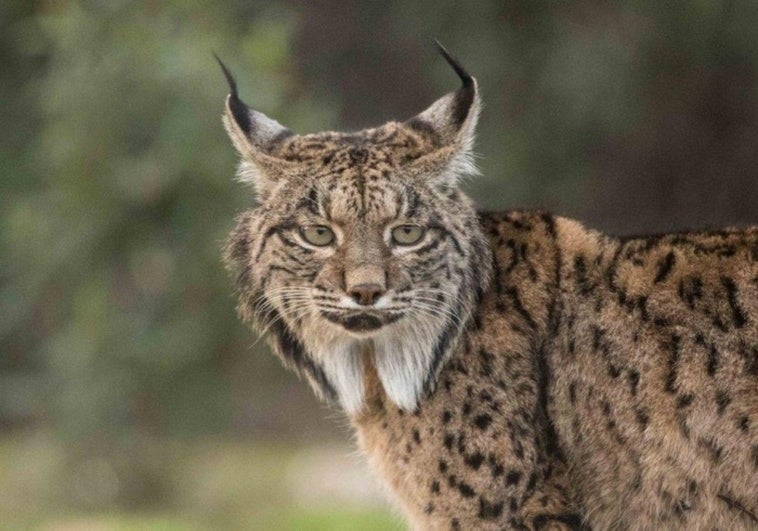Previously endangered Iberian lynx hits a record high in Andalucía
The region counted 836 speciments in 2024, some 40.8% of the whole of mainland Spain, although Castilla-La Mancha has the biggest population with a total of 942
The Iberian lynx continues its extraordinary recovery in Spain and with a continuous growth in numbers which led the population to reach a historical maximum in 2024. A total of 2,401 specimens were counted, which represents an increase of 19 per cent over the previous year.
This encouraging figure for the animal "is evidence of a positive demographic trend that has continued over the last 20 years of monitoring and action aimed at reducing the risk of extinction", according to Spain's Ministry for Ecological Transition and the Demographic Challenge. The ministry has provided monitoring data on the species from all of Spain's regions where the animal is present, as well as with Portugal. These statistics place the majority of the population in Spain, with 2,047 individuals, representing 85.3% of the total, while the remaining 14.7% live in Portugal, with 354.
Andalucía is home to 836 lynx, which represents 40.8% of the total, although Castilla-La Mancha has the highest number, with 942 specimens, or 46% of the population. Other regions with lynxes are Extremadura, home to 254 specimens, representing 12.4%, and Murcia, which currently has 15, or 0.73%.
The three main geographical areas in Andalucía with the highest number of lynxes are in Sierra Morena, with 1,082 individuals counted, many in core areas shared with the bordering lands of Castilla-La Mancha. 638 in the eastern Sierra Morena in Jaen and Cordoba, and 53 in areas of connection with Castilla-La Mancha, specifically 444 lynxes in various nuclei in the provinces of Ciudad Real and Albacete.
Of the total number counted, 1,557 lynx were adults or young with 708 males and 706 females. The number of breeding or territorial females rose to 470, 64 more than in 2023, which is gradually approaching the 750 breeding females that are considered as one of the demographic objectives to be reached in order to consider the lynx to no longer be considered an endangered species. The number of cubs born in 2024 also increased to 844.
At a national level, the species now breeds in 17 different geographical areas. In fact it was in danger of extinction at the beginning of the 21st century but in the space of 23 years its population has multiplied by 24, as it has gone from less than 100 specimens, very isolated in Doñana and the Sierra de Andújar and Montoro counted in 2002, to more than 2,400 at present.
Last year it went from being "endangered" to being a "vulnerable" species, although it is still considered to be highly threatened. For this reason, the lynx conservation programme has incorporated new reintroduction areas in recent years, including Murcia in 2023, and this year it is going to expand north to Castilla y León, where work has begun on releasing the first lynx in Cerrato Palentino.
A global example in species recovery
The Andalusian regional government valued as "excellent news for Andalusian biodiversity" the latest data on the lynx census and stressed that its recovery is already considered "a world example of species conservation". This was emphasised by the regional spokesperson for the environment and sustainability, Catalina García, who highlighted "the role of Andalucía as a key region in the recovery of this emblematic species". According to García, "this recovery is the result of a joint effort involving scientists, ecologists, landowners, farmers, hunters, NGOs and public administrations, united by the same objective: to guarantee the future of the Iberian lynx". Catalina García highlighted the "increase in breeding territories and in the number of cubs born, especially in Andalusian areas such as Guarrizas, Sierra Arana, the Sierra Norte de Sevilla and the Guadalquivir countryside". She also stated that "the data confirm the consolidation of new stable and viable population nuclei, thanks to the reintroduction and conservation protocols promoted by the Junta within the framework of the different LIFE projects". The World Wildlife Fund (WWF) also expressed its satisfaction with the positive evolution of the lynx population in Spain and Portugal and advocated continuing to work collaboratively, as it has done in the last two decades, to eliminate the multiple threats that endanger the survival of the species. The conservation organisation pointed to poaching, illegal hunting and roadkill as problems for the lynx. In addition, the WWF was particularly concerned about the decline in the population of the wild rabbit, the lynx's main prey and livelihood, which has decreased by 70 per cent in its natural habitats in the last 10 years.

